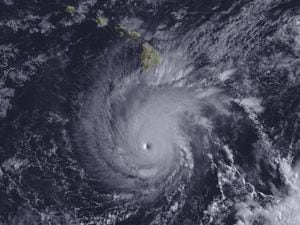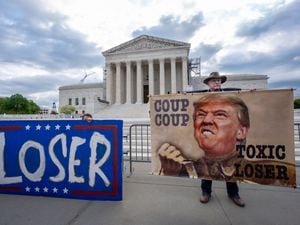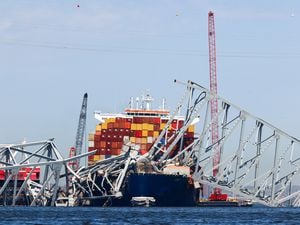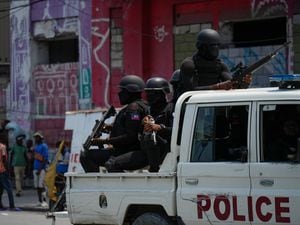Hurricane Lane soaks Hawaii’s Big Island
It is the state’s first hurricane since 1992.

Hurricane Lane has soaked Hawaii’s Big Island, dumping 12in of rain in as many hours as residents stocked up on supplies and tried to protect their homes ahead of the state’s first hurricane since 1992.
The National Weather Service warned that some areas could see up to 30in before the system passes.
Bands of rain extended 350 miles from the hurricane’s centre.
“Even though the eye is south of the Big Island, we are seeing excessive rainfall already affecting the islands,” weather service meteorologist Gavin Shigesato said from Honolulu.
Tropical storm conditions, with winds of 73mph, were expected to reach the Big Island, Hawaii’s eastern-most major island, later on Thursday morning, with hurricane conditions possible later in the day.
As of 2am, the hurricane was 335 miles south of Honolulu and moving north west.
Maximum winds had weakened slightly to 130mph, Mr Shigesato said.
The storm was expected to turn to the north later on Thursday and into Friday, with little change expected in forward speed.
The centre could move close to or over portions of the main islands on Thursday or Friday.
Then the storm is likely to turn to the west on Saturday and Sunday and pick up speed, forecasters said.
On Wednesday, the hurricane’s speed slowed from 9mph to 7mph, Mr Shigesato said.
A slower hurricane increases the threat of flash floods and landslides because of prolonged rainfall.
The arrival of the storm’s outer bands made the threat seem more real.
“Everyone is starting to buckle down at this point,” said Christyl Nagao, of Kauai.
“Our families are here. We have businesses and this and that. You just have to man your fort and hold on tight.”
Shelters opened on Wednesday on the Big Island and on the islands of Maui, Molokai and Lanai.
Officials urged those needing the Molokai shelter to get there soon because of concerns that the main motorway on the island’s south coast could become impassable.
On the island of Oahu, which was put on a hurricane warning late on Wednesday, shelters were scheduled to open on Thursday.
Officials were also working to help Hawaii’s sizeable homeless population, many of whom live near beaches and streams that could flood.
Hawaii Emergency Management Agency administrator Tom Travis said there is not enough shelter space statewide and advised people who were not in flood zones to stay home.
Authorities also warned that the shelters are not designed to withstand winds greater than about 40mph and that for most people they should be a “last resort”.

“Whenever possible, the public should plan to shelter in place or stay with family or friends in homes outside of these hazard areas that were designed, built or renovated to withstand anticipated conditions,” the city and county of Honolulu said in a statement.
Hurricanes are ranked 1 to 5 according to what is known as the Saffir-Simpson Hurricane Wind Scale.
Lane is at Category 4, with winds from 130 to 156mph.
Melanie Davis, who lives in a Honolulu suburb, said she was gathering canned food and baby formula.
“We’re getting some bags of rice and, of course, some Spam,” she said of the canned lunch meat that is popular in Hawaii.
She was organising important documents into a folder – birth and marriage certificates, social security cards, insurance paperwork – and making sure her three children, all under four, have flotation devices such as swimming vests “just in case”.
Public schools were closed for the rest of the week, and local government workers were told to stay home unless they are essential employees.
Meteorologist Chevy Chevalier said Lane may weaken to a Category 3 by Thursday afternoon but that would still be a major hurricane.
The central Pacific gets fewer hurricanes than other regions, with only about four or five named storms a year.

Hawaii rarely gets hit. The last major storm to hit was Iniki in 1992. Others have come close in recent years.
Unlike Florida or Texas, where residents can get in their cars and drive hundreds of miles to safety, people in Hawaii are confined to the islands and must stay put.
They have to make sure they have enough supplies to outlast prolonged power outages and other potential emergencies.
The Federal Emergency Management Agency has several barges with food, water and supplies that it moved into the region ahead of Hurricane Hector, which skirted past the islands more than a week ago, according to FEMA administrator Brock Long.
The US navy was moving ships and submarines out of Hawaii.
All vessels not currently undergoing maintenance were being positioned to help respond after the storm, if needed.
President Donald Trump issued a disaster declaration on Wednesday, authorising the Department of Homeland Security and the Federal Emergency Management Agency to co-ordinate disaster-relief efforts with the state.





